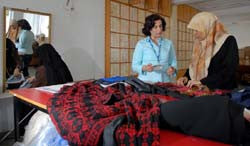UNRWA Sulafa Embroidery Project
 Location: Gaza Strip
Location: Gaza Strip
Beneficiaries: 400 women from 8 refugee camps

The United Nations Relief and Works Agency for Palestine Refugees (UNRWA) established the Sulafa Embroidery Project in 1950 as a part of their Social Service Programme. The project works in 8 refugee camps throughout the Gaza Strip.
With unemployment at over 45%, women in Gaza bear an increasing burden of supporting their families. By receiving the embroidery work, women earn an average of US$40 per month, a significant amount in an area where most people live below the poverty line (US$2/day per household).
Although it is labour-intensive and time-consuming work (a single scarf can take over 100 hours to make), hundreds of women are willing to embroider as many stitches as they can while juggling household responsibilities, in exchange for a wage that would afford basic subsistence for their families’ survival. The Gazan women’s artisanship and resilient spirits are reflected in the beauty of their products.
View our product range from the UNRWA Sulafa Embroidery Project here >>
These products are certified Fair Trade: creating opportunities for disadvantaged producers, sustaining fair working conditions and wages, empowering women, and preserving traditional crafts and artisan skills.

Cross-stitch embroidery in Palestine
Once a traditional craft practiced by village women, Palestinian cross-stitch embroidery has become an important symbol of Palestinian culture. Embroidered pieces can be found in the homes of most Palestinian families in the West Bank, Gaza Strip, Israel and the Diaspora beyond, adorning the walls of houses in Jerusalem, villas in the Gulf, suburban homes in the United States, and cement block houses in refugee camps. In addition, cross-stitch embroidery is given as gifts and worn by Palestinians worldwide on festive occasions.
The popularity of embroidery springs from both its beauty and its association with the Palestine of the past. Common patterns reflect the millennia-long history of the land. The designs are derived from sources as diverse as ancient mythology and foreign occupations and date as far back as the Canaanites, who lived in the area over three thousand years ago.
The handicraft also symbolises the traditional rural lifestyle of Palestine, much of which was lost after the 1948 creation of the state of Israel. Embroidery was the principal decoration of rural women's clothing. It was part of a village women's daily routine and a means of showing off her personal skills and social identity. The patterns, colours and quality of the dress reflected a woman's social standing, marital status and wealth.
Although the Palestinian cultural landscape has changed dramatically in the last fifty years, cross-stitch embroidery has remained a vibrant handicraft because, for many Palestinians, it is a familiar reminder of Palestine in the days of their grandparents or great-grandparents.
